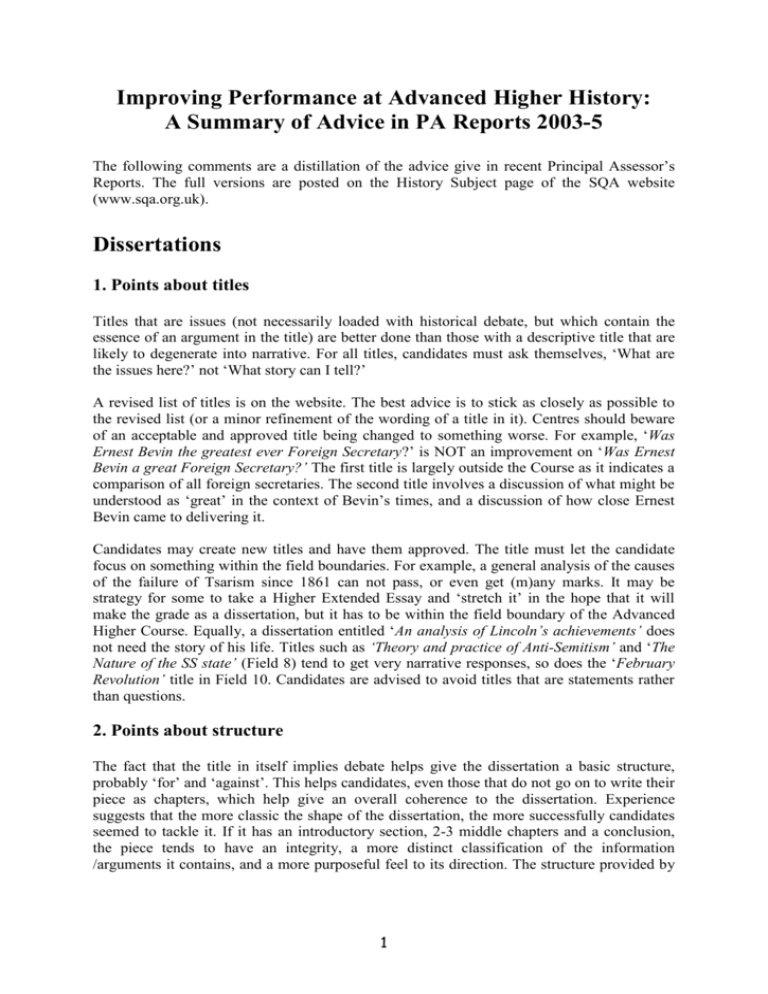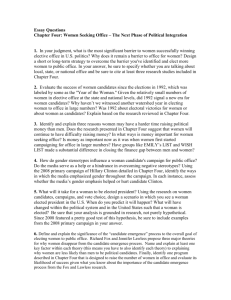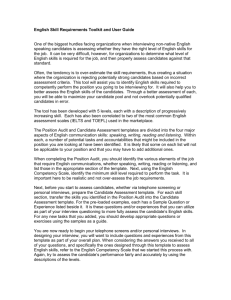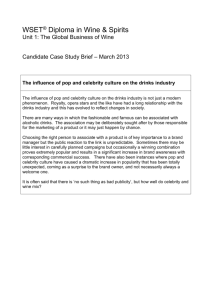Dissertation
advertisement

Improving Performance at Advanced Higher History: A Summary of Advice in PA Reports 2003-5 The following comments are a distillation of the advice give in recent Principal Assessor’s Reports. The full versions are posted on the History Subject page of the SQA website (www.sqa.org.uk). Dissertations 1. Points about titles Titles that are issues (not necessarily loaded with historical debate, but which contain the essence of an argument in the title) are better done than those with a descriptive title that are likely to degenerate into narrative. For all titles, candidates must ask themselves, ‘What are the issues here?’ not ‘What story can I tell?’ A revised list of titles is on the website. The best advice is to stick as closely as possible to the revised list (or a minor refinement of the wording of a title in it). Centres should beware of an acceptable and approved title being changed to something worse. For example, ‘Was Ernest Bevin the greatest ever Foreign Secretary?’ is NOT an improvement on ‘Was Ernest Bevin a great Foreign Secretary?’ The first title is largely outside the Course as it indicates a comparison of all foreign secretaries. The second title involves a discussion of what might be understood as ‘great’ in the context of Bevin’s times, and a discussion of how close Ernest Bevin came to delivering it. Candidates may create new titles and have them approved. The title must let the candidate focus on something within the field boundaries. For example, a general analysis of the causes of the failure of Tsarism since 1861 can not pass, or even get (m)any marks. It may be strategy for some to take a Higher Extended Essay and ‘stretch it’ in the hope that it will make the grade as a dissertation, but it has to be within the field boundary of the Advanced Higher Course. Equally, a dissertation entitled ‘An analysis of Lincoln’s achievements’ does not need the story of his life. Titles such as ‘Theory and practice of Anti-Semitism’ and ‘The Nature of the SS state’ (Field 8) tend to get very narrative responses, so does the ‘February Revolution’ title in Field 10. Candidates are advised to avoid titles that are statements rather than questions. 2. Points about structure The fact that the title in itself implies debate helps give the dissertation a basic structure, probably ‘for’ and ‘against’. This helps candidates, even those that do not go on to write their piece as chapters, which help give an overall coherence to the dissertation. Experience suggests that the more classic the shape of the dissertation, the more successfully candidates seemed to tackle it. If it has an introductory section, 2-3 middle chapters and a conclusion, the piece tends to have an integrity, a more distinct classification of the information /arguments it contains, and a more purposeful feel to its direction. The structure provided by 1 chapters helps candidates do a better job of classifying their material and arguments. It tightens the whole process up and deters some candidates from a non-analytical, narrative ramble through a topic that is almost bound to lead to a fail. It remains the case that some candidates do cope very well with a continuous piece of work. For the bulk of candidates, however, it is recommended that they consider the advantages that come from a chapter layout. The Introduction sets the dissertation up, it helps to contextualise the issues, it interests and intrigues the reader, and it points out the general route the debate will take. It gives an idea of the quality of analysis which lies behind the dissertation. If this is done poorly (or not at all), and left to be worked out, the reader becomes less confident of the quality of the dissertation. A good dissertation can overcome a weak introduction, but there is no doubt that first impressions count, and candidates should take time and give due thought to the way they begin their dissertation. Equally, the Conclusion has to be more than a summary of everything that has gone before, or a rehearsal of the Introduction. Readers look for synthesis and some form of qualitative judgement of the relative merits of the different factors that were considered. 3. Word length If the 4000 word rule is infringed, even by a small amount, there is an automatic penalty of 5 marks that is very difficult to claw back in the examination paper. There is no leeway on this. Centres should note that: (a) The 4000 word count is for TEXT of the dissertation only. This does not include the contents page, chapter headings, footnotes or bibliography or appendices. (b) Candidates should not attempt to gain an unfair advantage footnotes or providing lengthy appendices. by heavily loading the (c) The criteria for an ‘A’ in the dissertation require that a response is ‘well organised’. A piece of work that is 2,000 words over the limit is clearly not. (d) Putting the word count on the bottom of each page of body text is very helpful, but if it then all adds up to more than the declared and signed for ‘under 4,000’ total on the front, then the 5 mark penalty is applied. (e) Writing “around 4,000” is almost guaranteed to get the markers counting. (f) Markers do check the word count. At the other end of the spectrum, highly abbreviated dissertations that barely reach 3,000 words do not condemn a candidate to an automatic fail, but candidates penalise themselves by doing this. It is difficult to see how there can be the appropriate depth and development of the chosen topic if the candidates have chosen to write only three quarters of the possible amount. 2 4. Points about footnotes and bibliographies Excessive footnotes are ignored when reading the dissertation, and in arriving at a mark. The bibliography is helpful to markers; it lets them see the width and quality of the reading that has been done; and the markers can then see for themselves whether any of that reading has shown itself in the ideas that are expressed in the dissertation itself. Candidates should be warned against the dangers of ‘binge-sourcing’; there is no point filling the bibliography with an array of titles which show no sign of their authors’ ideas ever having percolated into the candidate’s thoughts. There are a lot of good new big one-volume efforts or Access sets for some fields nowadays, (Hite and Hinton, Corin and Fiehn, Farmer etc) but ambitious candidates should go beyond these and read some of the actual books by the authors themselves. This indicates that candidate has really engaged with the debate. A dissertation with too many footnote references to class text books tends to suggest the ‘worthy trier’ rather than the ‘higher-flyer’. In some fields, there is an over-reliance on the Support materials. The Support materials are the beginnings of the resources road, not the end. However, whilst some markers have reported on a ‘poverty of scholarship’, others have noted with satisfaction the impressive understanding that some candidates have gained from a wide range of up-to-date books. 5. Points about plagiarism Candidates should use quotes sparingly but effectively. They should attribute them in references/footnotes. This applies to both books and internet sites. Candidates should avoid incorporating other writers’ work into theirs verbatim, without attribution. Markers are experienced teachers/lecturers who will almost certainly spot this contrast. 6. Historiography Dissertations require historiography to pass. Best practice is to support points with evidence and with views of attributed authors/schools of thought where appropriate, as paragraphs develop. Contrasted views are excellent in illustrating historical debate. Many markers comment on the difficulty some candidates have in integrating historiography into the development of the issues. It is poor practice in a dissertation to hand in a piece which is 75% narrative, with a historiographical section tacked onto the back as the last chapter/or conclusion. This is clumsy to say the least, but by the time the marker gets to the historians’ analysis at the end, the dissertation may have already been consigned to failure by the sheer quantity of ‘story’ that has already been looked at. The skill of how to construct a good quality dissertation may need to be taught directly. 3 6. Points about typography and proof reading It is the candidate’s responsibility to ensure that their best work has been properly organised and delivered on time. Dissertations should be proof-read, to eliminate typographical errors, check that sentences that make sense and that there are no pages missing or out of order. The font should be reader-friendly. Dissertations should be enclosed in the cellophane wallet provided. It is within the purview of the teacher/lecturer responsible to take some involvement in these ‘literacy’ aspects of their pupils’ work. It is acceptable to: 1. Point out if it is over 4000 words 2. Insist in the class that candidates check each other’s work and use the red pen on misspellings and poor sentence structure or grammar 3. Ask if their parents have read it, to see if they thought it made sense; another pair of eyes can pick up errors. 4. Plan and push dissertations through in good time, so that they do not come in at the last minute without having time to be properly checked. Examination Questions Essays Best practice is to focus on what the question actually asks the candidate to do, and then to go consider further implications of the question and the issues and debates involved. Candidates should answer the question in the paper, and not one they wished had come up. Merely rehearsing a revised answer to a previous question is not sufficient at this level. Some weaker candidates still ‘recognise’ the topic area that the question refers to, then give everything they know on that topic, hoping that somewhere along the line they answer the question. This technique generally leads to failure. Historians’ ideas permeate the best essays. These essays have a clear sense of reviewing key historians’ views on an issue, and read convincingly as pieces of Advanced Higher work. Candidates should refer to the authorities from whom their ideas came. While not all essays lend themselves to a keen historical debate with key schools of thought arguing the case, all essay titles are open enough for the candidate to include some signs of their reading on that issue. Candidates should try to move beyond the very generalised ‘some historians have argued…’ Candidates must include reference to historical interpretations in their essays to achieve a pass. 4 The source questions Sources are drawn from the areas of the course italicized. This information is on the SQA website, as part of the section on Arrangements Documents and Specimen papers; under the section on Advanced Higher, click the title ‘Advanced Higher Expanded Descriptors’. Markers are keen to reward what the candidate has offered in terms of showing ability of the historical sub-skills wanted in each question. These are: accurate interpretation of the views in the source; provenance comment for some source answers; inclusion of relevant immediate and wider contextual recall to validate or criticise views in the sources; and reference to the views of historians as part of that contextualisation. Exemplified answers to the ‘How useful …’ question were published on the SQA website in May 2005. Centres should study the commentary that was attached to each A and C exemplified answer. This may be a more ‘mechanistic’ way of marking but is an attempt to reward candidates for what they do; it lets the marker positively respond to what the candidate provides for this range of historical skills. The 2005 marking schemes have a new rubric at the start of each source question, clarifying what the candidate has to do to earn the marks for that question. Centres may wish to look again at the exemplified ‘How useful…’ answers that were issued, and appreciate that the style of marking used there is also applied to the other source questions. Some provisos…. (a) Provenance marks in source questions are now largely to be earned in the ‘How useful...’ question. There may be provenance comments rewarded in the two source question if one of the sources is a primary source. (b) Good responses to provenance at Advanced Higher are a form of contextualisation, in which the candidate locates the source in history: “Why was it that person saying it?”; “Why did it matter?”; “Why then and in that way?”; “Was it the same as previous or later views?” It is answers to this sort of question which help locate the source and establish its usefulness. This is still origin and purpose but on a qualitatively higher level than, for example, ‘This is from Lenin, he was leader of the Bolshevik party and knows what he is talking about…’ Some candidates still answer at an elementary level. A reminder to the marker by the candidate that it is a primary source, then a repetition of the source rubric on date and who said it, does not merit marks for provenance at Advanced Higher. (c) In the ‘How fully…’ question there may be a possibility of the candidate making provenance comments, but this source will usually be a secondary source and candidates will therefore be awarded such marks under historiographical context. (d) The two source questions ask about interpretation of the two views and how far they can be supported. As well as saying how much the two given sources offer as viewpoints or interpretations (i.e. they give a for and against, and what has been missed out from those sources) candidates should go on to suggest what other perspectives might be appropriate to consider, in terms of reference to historians’ views. 5 (e) In all source questions there is scope for the candidate to bring in historians and their views as part of their wider contextual development. Candidates are unlikely to score near the top of the marks range if they include no references to historical interpretations. (f) With a mark allocation for a certain skill, this inevitably places a ceiling on the mark for that skill. This assures some balance in the answers. Candidates should not write too much on, for example, interpretation of source content (only 3 marks allocated in the ‘How fully...’ question or 2 marks in the ‘How useful...’). If they write more than that in just purely interpreting the view there are no additional marks! Equally of course, there is an allocation of marks for each skill, which means that if the candidate doesn’t do it at all then they miss getting all those marks. The best quality responses are where the candidate quickly sets the source in its context via provenance, before moving on to develop issues such as the nature (and scholarship where appropriate) of the view in the source, and something of the wider historical perspectives, that are necessary to contextualise the view. The formula for the two source question: It is helpful to contrast the sources at each stage. In these questions candidates should avoid lengthy comment on provenance (e.g. discussion on whether it is primary/secondary, memoir/contemporary). Some of this may come through naturally as the answer develops. Key point 1 There must be clear signs that the candidate recognised and understood the views in the sources. This does NOT mean paraphrasing the source or rewriting it. Having detailed what the views in the sources are, the candidate should supported these with information selected from the source, and corroborate it with additional supporting information from recall. The plan of action for each source might therefore be to say: 1. The view in the source is e.g. optimistic/pessimistic about, critical/favourable of, taking a line which emphasizes … 2. This because the source makes the comments that… 3. The reasons why this view is held are because…(this is where the recall comes in that shows the candidate has contextualised the view) Key point 2 The question requires consideration of the views in the sources as perspectives on an issue. This means that the candidate must clearly be able to show knowledge of some of the other perspectives it may be possible to hold. This means the candidate might: (a) give additional recalled factual evidence which shows support for a different interpretation 6 (b) give additional information on differing schools of thought to which historians subscribe, which diverge from the views in the two sources (c) refer to different historians, by name or quoted comment, whose views either support or diverge from the sources. Key point 3 A strong conclusion is important. At the risk of seeming slightly formulaic, a possible start may be: ‘It can be seen therefore that the sources do shed light as perspectives on x because... But nevertheless one can see how valid other views are like...’ Additional recall of a factual nature can support or contradict the views in the source(s). This is best if integrated into the answer, but may come more naturally as a development of particular points. This type of recall is essential to achieve a pass in the question. Recall which illuminates various historical schools of thought may be seen as an enrichment of the answer, and is likely to be present in the best answers. Historiography In the source questions candidates should remember that historians’ views are a part of the wider contextual explanation for a historical event or issue. Academic historians at the cutting edge of research and immersed in the scholarship of their field provide incisive insights and evaluations. The thoughts of one well chosen historian can tell far more about an issue than a barrage of facts. Candidates who see the historiographical element as a clearly crucial part of the wider contextualising and ‘perspectives’ are able to enhance their mark beyond that of those who merely see wider context in terms of more, but different, facts. Further reference The full marking schemes for the 2003 papers onwards are available on the SQA website. The forms used by markers in assessing responses (the Ex Supplements) are available on the SQA website. Centres may find these useful when assessing their candidates. The more that centres understand about the process of marking (i.e. what the team awards mark for, the emphases in marking and the number of marks that are available for each aspect of an answer) then the better prepared their candidates can become. The best means of becoming aware of national standards is to mark for SQA. Individuals interested should contact the Qualifications Manager directly. 7







